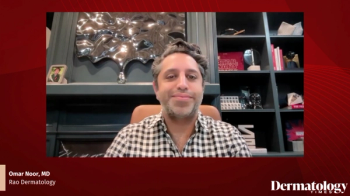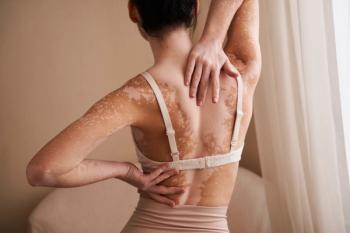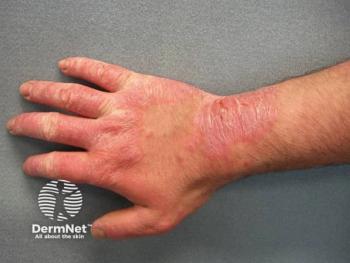
- Dermatology Times, April 2025 (Vol. 46. No. 04)
- Volume 46
- Issue 04
Personalized Approaches to Atopic Dermatitis: Balancing Burden, Treatment, and Patient Preferences
Key Takeaways
- Atopic dermatitis affects emotional health, self-esteem, and social interactions, often leading to anxiety and depression, particularly in children.
- Treatment escalation from topical to systemic therapies is based on clinical criteria and patient-specific factors, with newer therapies offering high efficacy.
Raj Chovatiya, MD, PhD, MSCI, explores case-based approaches to managing atopic dermatitis, focusing on treatment strategies, challenges, and clinical insights for improving patient outcomes.
In a recent Dermatology Times Case-Based Peer Perspectives custom video series,
The Burden of AD on Quality of Life
As Chovatiya emphasized, AD affects emotional health, self-esteem, and social interactions, with patients often facing stigma because of the visible nature of their skin inflammation. “When you think about it, if you have a condition that has inflammatory cutaneous changes on the skin, it’s going to change the way you might view yourself and the way the world views you,” he said.
This can lead to challenges in self-image and a reluctance to engage socially or professionally. Additionally, the physical symptoms, such as persistent itching, skin pain, and sleep disturbances, exacerbate the condition’s negative effects, creating a cycle of discomfort and fatigue that hinders daily functioning.
The psychosocial burden of AD is substantial, contributing to anxiety, depression, and emotional distress, particularly in pediatric patients. Chovatiya highlighted the connection between AD and comorbid conditions such as asthma and food allergies, which often require a holistic treatment approach. “The more severe the disease, the more the impairment,” he said.
Deciding When to Escalate Treatment
The decision to escalate treatment for moderate to severe AD from topical therapies to systemic therapies is nuanced and often based on a combination of clinical criteria and patient-specific factors. “I try to take a much more pragmatic approach in real-world practice and ask my patients: ‘Is there something that your disease prevents you from doing or succeeding at or really doing the best you can in day-to-day life?’” he said.
In recent years, the landscape for managing moderate to severe AD has shifted dramatically with the approval of targeted systemic therapies. The efficacy of newer therapies such as oral Janus kinase (JAK) inhibitors and biologics tends to be high, with many patients achieving long-term symptom control, but treatment choice ultimately depends on the patient’s specific needs, concerns about adverse effects, and how their disease impacts daily life, Chovatiya explained.
An 8-Year-Old Girl With Poor Response to Topical Therapy
Chovatiya discussed a case of an 8-year-old girl with moderate to severe AD who was experiencing significant quality-of-life issues, including severe itching, sleep disturbances, and secondary skin infections. Despite using topical treatments such as corticosteroids and calcineurin inhibitors, her condition remained poorly controlled, leading to school absences and frustration for both her and her family.
Given the failure of conventional topical treatments, systemic therapy with dupilumab (Dupixent) was considered. “This is when we really need to start thinking about adjusting our therapeutic strategy,” Chovatiya said.
A 35-Year-Old Man With Skin of Color and Worsened AD Severity
Chovatiya also discussed the case of a 35-year-old Black man with a history of AD that had worsened in recent years. Despite using emollients, corticosteroids, and calcineurin inhibitors, his symptoms—particularly intense itching, poor sleep, and hyperpigmented plaques—remained poorly controlled, affecting both his work and quality of life. Additionally, he had comorbidities such as asthma, allergic rhinitis, and seasonal allergies.
Given the persistence of his symptoms, treatment options included biologics such as dupilumab, tralokinumab (Adbry), lebrikizumab (Ebglyss), and nemolizumab (Nemluvio), as well as oral JAK inhibitors. “The choice of treatment should be guided by his specific symptoms, preferences, and comorbidities,” Chovatiya said, “with careful consideration of the route of administration and potential [adverse] effects.”
A 28-Year-Old Woman With Concerns of Skin Thinning
Chovatiya also discussed a case involving a 28-year-old woman with worsening moderate AD and a history of chronic dry eye. Despite trying various emollients, topical corticosteroids, and crisaborole (Eucrisa), she had seen little improvement and presented with concerns about skin thinning, particularly on her hands. She was seeking an effective treatment that worked quickly and did not require injections.
After discussing therapeutic options, Chovatiya suggested considering oral JAK inhibitors because of their rapid onset of action and ability to address multiple disease domains. The patient was prescribed an oral JAK inhibitor, upadacitinib (Rinvoq), based on her preference for oral therapy and the potential for quicker symptom relief.
Conclusions
Chovatiya emphasized a holistic approach to treating AD, urging clinicians to consider the patient as a whole rather than making rapid, surface-level assessments. He highlighted the importance of shared decision-making, as patients may have varying priorities regarding treatment speed, efficacy, and administration routes. With an expanding array of treatment options, Chovatiya stressed the need to match the right therapy to the right patient.
“Sometimes it’s just a matter of figuring out what is going to be the best treatment, giving you the best result possible,” he said.
Articles in this issue
8 months ago
Dermatology Times April 2025 Print Recap8 months ago
Expert Insights From AAD 20258 months ago
How to Best Support Women With Menopausal AcneNewsletter
Like what you’re reading? Subscribe to Dermatology Times for weekly updates on therapies, innovations, and real-world practice tips.



















